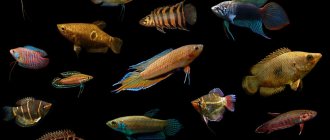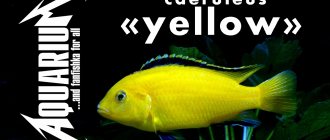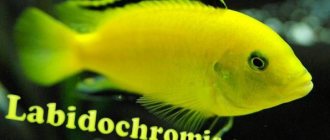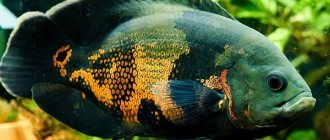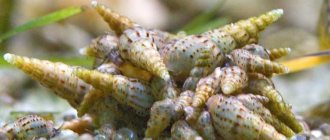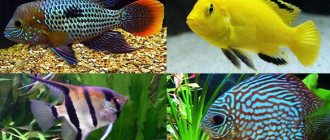Labidochromis yellow, or labidochromis caeruleus var. Yellow, is the most popular labidochromis fish.
Its bright color is one of 13 possible variations. Belongs to the cichlid family, the mbuna group, and is distinguished by its peaceful disposition for cichlids.
Caring for the fish is quite simple, which makes it suitable for keeping in a home aquarium for both beginners and experienced aquarists.
Kinds
Labidochromis is endemic to Lake Malawi in Africa. The most popular aquarium Malawian cichlids include 8 varieties .
Labidochromis yellow
The fish got its name from its lemon-yellow color. On the dorsal fin there is a black stripe that runs through the entire plumage.
This cichlid is considered small, but its body size can reach up to 10 cm.
Hongi
Quite a rare fish, but its popularity among aquarists is gradually growing due to the unusual color of the cichlid.
Males are blue or light blue in color, but in the frontal part, on the back of the head and on the dorsal fin, the color can range from yellow to bright orange.
Interesting! Juveniles and females are much paler, most often brown with pale orange dorsal plumage.
An adult fish can grow a little more than 13 cm, juveniles about 9 cm.
Kimpuma ed.
These rather large cichlids are artificially bred morphs of Hongi. Their distinctive feature is the color of the head, occipital and dorsal parts, which can range from reddish-orange to bright red.
Males in an aquarium grow up to 11–12 cm, and females - up to 10.
Interesting! Using this species as an example, it was found that during the absence of the male, the older female can change color to a color characteristic of the stronger sex.
Moreover, over time, she changes her sexual role, taking part in spawning as a male, while losing the ability to lay eggs.
Mbamba Bay
Mbamba Bay has a beautiful blue body color with dark blue transverse stripes. The plumage is black with yellow edging. The fish is medium in size, usually no more than 10 cm.
Chizumulu
It is considered a dwarf cichlid, since the size rarely exceeds 9 cm, and females can be up to 7 cm.
The females of this species have a modest cream or beige coloration, while the males are distinguished by a soft blue hue with dark transverse stripes reaching the middle of the body.
Nkata Bay
Labidochromis nkata bay, however, like many other cichlids, was named after the place where it was first caught.
The fish has a beautiful white color with a pearlescent tint, the plumage is transparent blue with a black stripe - the mark is missing only on the caudal fin.
Textile
The color of this fish is unique and looks more like a patterned blanket than a natural creation.
The blue color of the body is speckled with brown specks, which form longitudinal stripes running from head to tail.
The size of the cichlid is modest - only 7 cm.
Blue
Males are brighter colored than females, their blue bodies are lined with blue or purple transverse stripes. Can grow up to 12 cm.
Description
Labidochromis cerulius was first described in 1956 and classified as an endemic species found in Lake Malawi.
Natural habitat
Cerulius prefer fresh, warm reservoirs with a rocky bottom . They like to hide in small caves and under snags.
Appearance
The characteristics of the fish are as follows:
- the body is elongated, slightly flattened laterally;
- the color is bright, rich, without bald spots, the plumage has a black edging (on the anal and ventral fins too);
- black eyes, very expressive;
- in an aquarium, cerulius grows up to 10 cm, while in a natural environment its size does not exceed 8 cm.
View this post on Instagram
Posted by Cichlid Kmv (@cihlida_malawi_kmv) Apr 11, 2021 at 9:20 am PDT
Lifespan
If you do not violate the recommendations for care and maintenance, then labidochromis can live up to 10 years.
Natural habitat
The blue acara is a lobe-finned fish from the large family of cichlids. It has a high ability to adapt, therefore it is found in bodies of water with different characteristics - muddy waters of swampy lakes, clear waters of streams and fast-flowing rivers.
Researchers believe that acara appeared in the rivers and lakes of northwestern Peru and in the Rio Esmeraldas River basin (Ecuador). They were able to expand their habitat to Trinidad and Tabago, part of Venezuela. Gradually, Akara conquers more and more places, spreading throughout the world.
Despite their adaptability, akars prefer water bodies with calm currents, rich in vegetation and small aquatic inhabitants. In thickets of plants, among snags and roots, fish find food and shelter from larger and more aggressive relatives.
The blue acara cannot be called a “small thing” - in nature it grows up to 30 cm.
And the character of the beautiful fish is far from angelic. Blue acara is a predator that feeds on fry, small fish, larvae and aquatic insects, small crustaceans.
Content
Among other cichlids, cerulius have the most peaceful character . The bright color and simple keeping conditions make it possible for labidochromis to be present in beginner aquariums.
Aquarium
It is better to choose a tank from 100 liters. It should contain grottoes, caves, stones, snags and vegetation - in general, all those elements that will serve as shelter for the fish.
Water parameters
The optimal temperature for cichlids is 25…27 °C. Water is required to be hard, from 1 to 25 units, with a bias towards alkaline with a pH of 7–8, rich in oxygen, for which a good purification filter and an aerator are installed.
Plants
Although in the environment familiar to Labidochromis there is no abundance of vegetation, flora is still needed for decoration and additional gas exchange .
It is best to place cryptocorynes and anubias in a reservoir with cichlids: ceruliuses do not eat them, and the bushes easily take root in almost any reservoir.
Priming
It is better to choose dark shades for the substrate; against such a background, labidochromis look even brighter.
The soil should contain:
- sand;
- stone or marble chips;
- crushed shells.
Equipment
Cichlids do not require bright light to live comfortably . These are bottom-dwelling fish, so the lighting for the aquarium should be dim, preferably with diffused light.
You will need a powerful water filtration system and a good compressor.
View this post on Instagram
Posted by Alexey Savinov (@pundikot) Oct 23, 2021 at 11:35 PDT
Reviews
Keeping turquoise acara in a home aquarium requires considerable attention and effort. The main thing you need to take into account is that it is not advisable to place this fish in cramped aquariums, and it does not successfully coexist with all representatives of aquarium fish.
Would you like to purchase this fish for your own aquarium? Share in the comments!
Feeding
In an artificial reservoir, fish are prone to overeating, so it is better to divide the daily food intake into two feedings: morning and evening .
Important! Labidochromis is a predator, like all cichlids; its mouth contains sharp, slightly curved teeth, which are designed to extract prey from crevices in rocks.
The fish diet can be constructed as follows:
- plant-based dry food;
- small mollusks, insects, larvae and crustaceans;
- seaweed;
- spirulina tablets;
- plants (lettuce, dandelion leaves).
Content compatibility
Cerullis are peaceful compared to other cichlids, but can be incredibly cruel to other fish. The best neighbors for them will be:
- other cichlids of comparable size;
- ancestrus;
- corridors;
- blue dolphins;
- cockroaches.
You should not put yellow in the same aquarium with labidochromis:
- angelfish;
- guppy;
- swordtails;
- zebrafish;
- barbs;
- goldfish;
- platy.
Price
As a rule, the cost of a fish directly depends on its size, age and other individual characteristics. On average, the cost of a turquoise akara starts from 200 rubles. An adult will cost much more - its cost can even reach several thousand rubles.
Also, those who are thinking about buying a turquoise acara should take into account that they will additionally need to purchase equipment, in particular, a spacious aquarium with a filter and filling for it: natural sand or small pebbles, decorative elements and much more.
Breeding
It is optimal to form small flocks, where there are 2–3 females per male . Males show aggression towards each other, which causes their plumage to suffer.
Male and female: how to distinguish
Sexual dimorphism in Labidochromis yellow is weakly expressed, and it can be difficult for beginners to make out who is who.
During the spawning period, males usually acquire brighter colors than females . Another difference is the shape of the forehead: in males it is more convex, and their ventral fins are black.
Spawning
Cerulis do not need to create special conditions for reproduction; they manage to produce offspring even in the presence of more aggressive neighbors. But to preserve the brood, it is better to remove the female from a common reservoir .
A separate aquarium of a relatively small volume is prepared, future parents are placed in it and fed well.
The male’s task is to prepare a place for safe spawning and attract the female there.
After spawning, the female sucks the eggs into her mouth and incubates it this way throughout the entire maturation period (24–39 days).
The fry are born completely independent.
Character and habits
The Blue Acara is considered one of the most peaceful cichlids. She gets along well with calm and active medium to large neighbors. But good nature greatly depends on the size of the territory. If the aquarium is densely populated or its size is small, then the blue acara will, with all the fury inherent in its relatives, attack its neighbors, winning back its space.
Some aquarists talk about partners attacking each other in pairs. This behavior indicates the crossing of territories. Aggression reaches its peak during the spawning period - the pair protects their clutch and fry.
The blue acara has a natural intelligence. The fish quickly get used to it and begin to recognize their owner and take food from his hands. Some even allow you to stroke and pick yourself up. Acaras form strong, harmonious pairs from an early age. Adults rarely form a pair, so when creating an aquarium you need to purchase a school of fish of different sexes and use the formed pairs for subsequent breeding.
Diseases
Most health problems in labidochromis occur due to violation of the conditions of detention or incorrectly selected neighbors in the aquarium.
Injuries
Most fish injuries occur due to fights between males and collisions with decorative elements.
Therefore, it is important to maintain the ratio of males and females in the tank so that the gentlemen do not show excessive aggression.
When installing new decorative elements, it is important to make sure that they do not have sharp protrusions or corners that could harm the fish.
Poisoning
Heavy metal salts, chlorine and ammonia dissolved in water can cause deterioration in the health of fish and lead to poisoning. Signs of intoxication are:
- loss of coordination;
- rapid breathing;
- decreased activity.
To prevent poisoning, reserve water for replacement. thoroughly, but without detergents , or it is better to keep them in a separate container for 3-5 days before installing them in the aquarium.
Tuberculosis
Unfortunately, it is almost impossible to save a sick fish. It is placed in a separate aquarium and a solution of vitamin B6 is added to the water. The disease enters the aquarium along with infected fish.
Ichthyophthirosis, or semolina
This disease is characterized by white dots that appear abundantly on the body of the fish. Zelenka is used as a treatment.
Fin rot
The disease is characterized by the appearance of a whitish coating on the plumage of fish, and then red stains. The fins are completely destroyed over time.
Antibiotics, brilliant green and gentian violet solution are used as treatment.
Aquarium setup
Due to their high territoriality and not the most accommodating nature, blue cancers are recommended to be kept in species aquariums. This makes it much easier for novice aquarists not only to maintain peaceful coexistence, but also to create ideal conditions.
It is recommended for 1 pair an aquarium with a bottom size of 120x30 cm and a volume of at least 70 liters. It is recommended to fill the bottom of the container with coarse sand, since fish like to arrange it in their own way - moving stones, digging ditches and holes, uprooting plants. Sand will prevent turbidity and allow the water to remain clean.
To construct shelters, specially prepared branches and driftwood are placed on the bottom. Grottoes with a wide entrance are made from large stones. You can use ready-made aquarium forms or build tunnels from scraps of plastic pipes.
The main condition is the strong fastening of decorative elements and fragments of shelters. A strong blue acara can break glass or break internal equipment, causing harm to the inhabitants of the aquarium and itself, arranging the territory to its liking.
Green plants will not only provide desirable cover for adult fish and growing fry, but will also provide an attractive backdrop for beautiful blue cancers. For landscaping, you need to select plants with a strong root system, strong stems and wide, dense leaves. It is also important to take into account the characteristics of the water.
Species that grow well in slightly alkaline and slightly acidic water can be placed along the back wall of a home pond, used to zone an aquarium, or arranged in separate groups:
- nymphea;
- ferns;
- gymnocoronis;
- giant vallisneria;
- hygrophila;
- cryptocoryne;
- Echinodorus;
- aponogeton ulvoides.
Cichlids are indifferent to floating plants. Therefore, you can create twilight and enrich the water with oxygen using:
- duckweed;
- salvinia floating;
- pistia;
- riccia;
- Azolla carolina.
Anubias nana bushes will look beautiful on driftwood. Plants not only need to be strong and tough to withstand the attacks of Blue Acara, but they also need to recover quickly.
Some aquarists advise replacing live plants in cichlids with dummies or doing without them altogether. But blue cancer has a fast metabolism and a good appetite, which causes water pollution with organic waste.
In order to remove nitrates, phosphates and other waste products of aquarium inhabitants, not only powerful filter systems are needed, but also a combination of them. Plants will also provide biological purification of water.
To recreate a natural biocenosis, it is necessary to maintain certain temperature and chemical parameters. For adult cancer, the following are favorable:
- temperature – 22-28°C;
- – 6,5-8,0;
- hardness – 90-447°.
For good health, fish also need filtration, aeration and weekly changes of up to 1/3 of the water volume.
It is better to place filters, heater and other service equipment outside to provide as much space as possible for the cancer.
Interesting Facts
Cerulius are very tenacious. They show amazing ingenuity in matters of safety and are able to survive in the same body of water even with larger predators.
Labidochromis willingly dig up the bottom in search of food . Sometimes they are able to move not too heavy decorative elements simply by pushing them.
If labidochromis fry are kept in a pond with plants, then there is a high probability that when they grow up, they will not eat the bushes.
Cerulius are very beautiful and unpretentious fish. They are easily adaptable and do not require special conditions , so even a novice aquarist can handle them.

